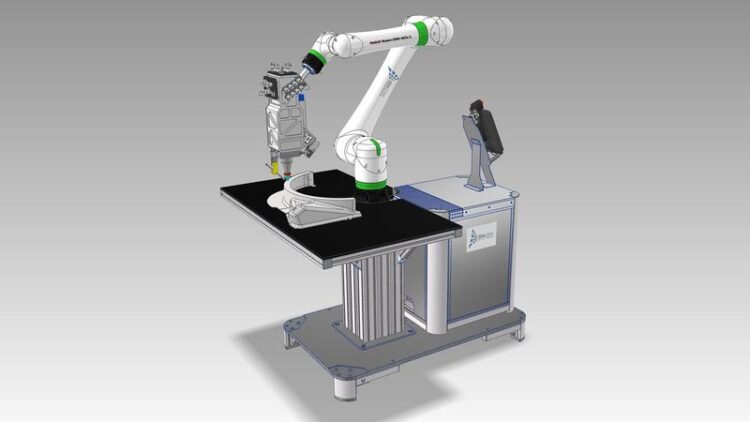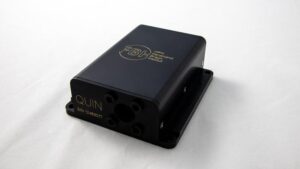High-power laser system for Additive Manufacturing

Schematic illustration of the SAMBA laser-wire-deposition processing tool based on direct-laser technology.
© SKDK GmbH
… and further new developments at Laser World of Photonics.
At the Munich trade show, the Ferdinand-Braun-Institut will be exhibiting, among other things, a robotic arm with a novel direct diode laser system for 3D printing. It will also present its diode laser and UV-LED portfolio – with advances in chip technology as well as modules and systems.
Once again, the Ferdinand-Braun-Institut, Leibniz-Institut für Höchstfrequenztechnik (FBH) will present its complete range of services at Laser World of Photonics in Munich from June 27 – 30, 2023 – from design to chips to modules and systems. At the Berlin-Brandenburg joint booth A2.421, FBH will showcase its diode lasers for applications in space, communication, medical technology, material processing, and quantum technology. Additionally, the institute will exhibit an irradiation system with optimized 233 nm UVC LEDs. This can be used to render multi-resistant pathogens and corona viruses harmless directly on the skin without damaging it.
FBH will present space-compatible developments and selected key components for quantum technology simultaneously in the World of Quantum halls at booth A1.231 of Research Fab Microelectronics (FMD). The institute will also attend the associated CLEO Europe conference with more than 20 scientific contributions.
Expertise in high-power diode lasers – demonstrated in the system
At the Berlin-Brandenburg booth, the institute and its partner companies Photon Laser Manufacturing and SKDK will demonstrate for the first time a flexible robotic arm with integrated laser beam source for Additive Manufacturing in lightweight construction. The kilowatt-class direct diode laser system features an unusual wavelength of 780 nm, which significantly improves efficiency in build-to-order technology. Due to the increased absorption, this applies in particular to the production of aluminum-based structures. Among other things, this will be used to manufacture customized side walls of high-speed trains with significantly reduced weight. Thanks to the compact size of the laser system, complex components can be manufactured even in very confined spaces. As it operates without optical fibers, it is also less prone to errors.
The basis of this and other laser systems for high-power applications are FBH’s diode laser stacks. They consist of innovative vertically stacked diode lasers that can be scaled up to kilowatt power levels. These diode laser sources are used as pump sources in material processing, free-space communication, printing, and medical technology – and increasingly also directly. In parallel, FBH continuously advances the laser properties at chip level, aiming for higher power, efficiency, and beam quality.
Edge emitter with 70% efficiency at 70 W output power
Researchers at the Ferdinand-Braun-Institut have realized diode lasers with 70 % efficiency at 70 W output power from a single emitter. The edge emitters with a wavelength of 915 nm are needed for pumping fiber lasers and direct use. They achieve higher powers due to the extremely wide emission apertures of 1.2 mm. The high efficiencies are based on advanced, highly vertical asymmetric epitaxial layer structures. FBH’s Buried-Regrown-Implant-Structure (BRIS) technology allows a lateral periodic oxygen implantation layer to be created near the active region of the single emitter. This ensures emission within a narrow angle.
High-performance pulse laser sources – from LiDAR to two-photon polymerization
FBH develops pulse laser sources with tailored properties for various applications. The integrated laser drivers are realized at the institute as well. Among the developments are high-power pulse laser sources for line scanners in the field of automotive LiDAR to detect objects three-dimensionally. These laser sources are based on diode laser bars with 48 emitters featuring a pulse peak power of 2 kW for 8 ns long pulses. They deliver fast laser pulses that are reflected by objects they encounter.
For the MERLIN climate satellite, which will measure methane concentrations in the atmosphere in the future, FBH has realized pump lasers, which will also be showcased at the fair. Equipped with two high-power laser half-bars, the system delivers 130 W of optical power at 808 nm in pulsed mode.
Scientists at the Ferdinand-Braun-Institut have also constructed a monolithic quantum well diode laser with a conical gain section that generates ultrashort pulses at 780 nm. The mode-locked tapered diode laser delivers 7 picosecond long pulses with a high peak power of more than 40 W. In the future, it could replace conventional Ti:sapphire lasers as pulse sources for two-photon polymerization (2PP), which are used to fabricate microstructures. This has already been successfully demonstrated with a single-line test structure using the 2PP technique. The structure was written using a similar monolithic mode-locked diode laser (830 nm) with just a single scan.
Sensor system for 3D quantum imaging

©FBH/A. Pubantz
In the QUIN project, FBH is currently developing a compact sensor head for 3D quantum imaging based on optical coherence tomography (OCT). For this purpose, the researchers use entangled photons in the mid-infrared range. The information is transformed in the sensor head from the mid- to near-infrared spectral range through the entanglement. If the sensor head is then combined with a high-resolution spectrometer in the near-infrared range, distance and structural data can be determined with previously unknown resolution.
The sensor system can thus provide precise 3D depth information using “undetected” photons in the mid-infrared range and can be used for quantum OCT for non-destructive examination of ceramic and polymer materials.
Weitere Informationen:
https://www.fbh-berlin.de/en/media-center/press-releases/high-power-laser-system…
Media Contact
All latest news from the category: Physics and Astronomy
This area deals with the fundamental laws and building blocks of nature and how they interact, the properties and the behavior of matter, and research into space and time and their structures.
innovations-report provides in-depth reports and articles on subjects such as astrophysics, laser technologies, nuclear, quantum, particle and solid-state physics, nanotechnologies, planetary research and findings (Mars, Venus) and developments related to the Hubble Telescope.
Newest articles

A blueprint for mapping melting ice sheets
Researchers in the Stanford Radio Glaciology lab use radio waves to understand rapidly changing ice sheets and their contributions to global sea-level rise. This technique has revealed groundwater beneath Greenland,…

Water hyacinth plant pots – utilization of an invasive species
Together with Fiber Engineering GmbH, the DITF presents a process for the production of biodegradable plant pots. The products are cost effective and competitive. At the same time, the production…

Current research on the new 6G mobile communications standard
Nursing care robots, autonomous driving, digital twins: all of these high-tech applications will play an essential role for the new 6G mobile communications standard. The first commercial 6G networks are…



